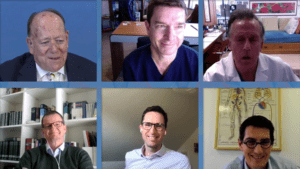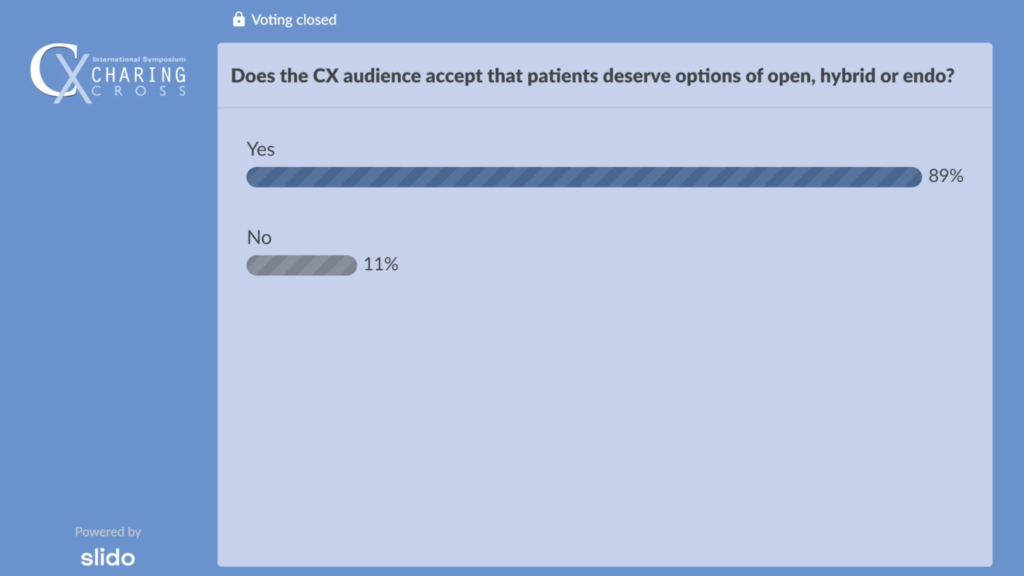
The message that outcomes depend on the underlying pathology was front and centre during the Thoracic Aortic Controversies discussion at the Charing Cross (CX) 2021 Digital Edition (19–22 April, online). The day also featured a decisive vote that patients should be offered open, hybrid, and endovascular solutions depending on what is most appropriate for them. This segued into panellists expressing a pressing need for high-volume expert aortic centres that are able to offer all of these treatments, as championed by Roberto Chiesa and team in Milan, Italy. Patient involvement in the decision-making was another important seam running through the discussion, as was agreement on reducing the place of hybrid procedures as physicians decide to offer either open or endo more frequently. In addition, it was noted that staged procedures are becoming more common in challenging anatomies, resulting in fewer complications, and the role of spinal drains in thoracoabdominal aortic aneurysm repair was addressed.
All Thoracic Aortic sessions are available to view on demand. Click here to register and access the recordings.
Pathology “must determine the mode of treatment”
Presenting an edited case of a fully percutaneous arch branch repair, Stéphan Haulon (Paris, France) highlighted the importance of selecting a procedure according to underlying pathology. In relation to the case presented, Haulon stressed the importance of choosing cases not at risk of emboli, detailing that he currently only performs this procedure on chronic dissection patients, who he stated are not at risk of stroke. In response to praise from the panel on the advanced nature of the procedure, the presenter was quick to emphasise the importance of a team approach in moving the field forward. “We all learn from each other”, he said.
Registrants can view this edited case on demand here.
Martin Czerny (Freiburg, Germany) addressed the learning curve associated with new technologies and echoed that view that pathology “must determine the mode of treatment”. He summarised that the frozen elephant trunk technique has “excellent” results and that the outcomes of total endovascular aortic arch repair are “promising”. He was keen to stress that the creation of aortic centres with the “entire armamentarium” will aid in “doing the right thing in the right patient”, and that “by learning from your environment, the learning curve with new technologies can be kept to a minimum”.
Registrants can view this presentation on demand here.
CX audience agrees patients deserve open, hybrid, and endovascular options
A number of presentations addressed the benefits and drawbacks of open, hybrid, and endovascular surgery. Summarising a presentation on “pushing the limits” of redo open arch surgery, Joseph Coselli (Houston, USA) argued that a multidisciplinary approach to a patient-tailored operation is “paramount”. In reasonable-risk patients, he added, the procedure should be extended to prevent recurrence, and stressed that all patient with redo surgery of the ascending or arch require lifelong imaging surveillance.
Registrants can view this presentation on demand here.
Also to address this topic was Luca Bertoglio (Milan, Italy), who spoke on choosing the right treatment for aortic arch disease, specifically when either open, hybrid, or endovascular would be appropriate. Comparing the three approaches, he concluded: open surgery has acceptable results in fit patients, adding that a frozen elephant trunk can be used if needed; hybrid is a good option in high- or moderate-risk patients; and a total endovascular approach is most fitting for redo surgery and in anatomically-suitable patients.
Registrants can view this presentation on demand here.

Discussion stressed the need for aortic centres that offer both open and endovascular solutions, with moderator Gustavo Oderich (Houston, USA) stressing that open and endovascular techniques “do not need to be in competition”. Polling sought to gauge audience opinion on the topic, and revealed that 89% of CX viewers accept that patients deserve options of open, hybrid, or endo.
Staged procedures in the spotlight
Another topic of discussion highlighted the fact that staged procedures are becoming more common, resulting in fewer complications. Dittmar Böckler (Heidelberg, Germany) presented an edited case showing TEVAR with staged deployment in challenging anatomies. He noted that staged deployment enables adjustment of placement and angulation, continuous blood flow ensuring haemodynamic stability, and opportunities to visualise and refine device placement.
Registrants can view this edited case on demand here.
In search of evidence for prophylactic or rescue spinal drains
Gustavo Oderich (Houston, USA) detailed thoracoabdominal aortic aneurysm repair without spinal drains. He concluded that cerebrospinal fluid (CSF) drainage is a “key component” of spinal cord ischaemia treatment and that the evidence for efficacy of routine prophylactic drainage is weak and drains are associated with significant risks in endovascular patients. He urged that a prospective randomised study of prophylactic versus rescue CSF drainage is needed.
Registrants can view this presentation on demand here.
All CX 2021 content is available to view on demand. Click here to access the recordings.













